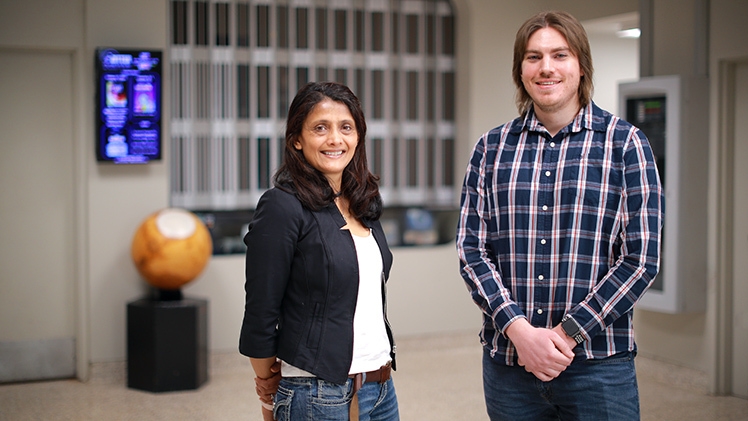Two University of Toledo astronomers will lead research on the fourth and latest cycle of scheduled observation time on the James Webb Space Telescope.
Dr. Rupali Chandar and Grant Donnelly advance an impressive record of engagement with the telescope at UToledo, where astronomers have led at least one research project on each cycle of scheduled observing time since it launched in December 2021.

Dr. Rupali Chandar, a professor and associate chair of the Department of Physics and Astronomy, and Grant Donnelly, a doctoral student studying physics with a concentration in astronomy, will lead fourth-cycle observing programs on the James Webb Space Telescope.
These opportunities remain highly competitive: Of 2,377 fourth-cycle proposals reviewed by the James Webb Space Telescope Allocation Committee, only 274 made the cut, accounting for a success rate of less than 12%.
“When the email came in and said, ‘Congratulations,’ I almost couldn’t believe it,” said Donnelly, a doctoral student earning his Ph.D. in physics with a concentration in astronomy. “I re-read the email like three times to make sure that it was true. It was a pretty incredible feeling.”
Donnelly is the third UToledo Ph.D. student in four cycles to submit a successful proposal to use the telescope. He works alongside Dr. J.D. Smith, his advisor, a professor of astronomy and director of the Ritter Astrophysical Research Center.
During his three allocated hours, Donnelly will collect infrared spectral data that will complete a uniform set of observations on the spiral galaxy NGC 4151.
NGC 4151 is of interest because of its active galactic nucleus, which is an active supermassive black hole that emits jets and winds. As an astronomer specializing in the interstellar medium, or the gas and dust that exist between stars, Donnelly is interested in exploring the data he will collect to understand the interaction between this active galactic nucleus and tiny molecules within the interstellar medium called polycyclic aromatic hydrocarbons or PAHs.
“In galaxies that have an active galactic nucleus, PAH emission in the infrared is different,” he said. “I’m interested in figuring out why that is and what it can tell us about galaxies.”
Chandar studies the star formation cycle and how it impacts the host galaxies as a professor and associate chair of the Department of Physics and Astronomy. With the success of her fourth-cycle proposal — her third successful proposal in four cycles on the James Webb Space Telescope — she’ll be turning the space telescope’s lens toward the Phantom Void in the Phantom Galaxy, also known as the spiral galaxy NGC 628.
The Phantom Void is a uniquely large hole in the gas and dust of the interstellar medium. It and others like it appear as bubbles or holes in star-strewn images of spiral galaxies already taken by the James Webb Space Telescope, including the widely distributed images taken by Physics at High Angular resolution in Nearby GalaxieS (PHANGS), an international research group that counts Chandar among its core members.
These phenomena are created by the extreme energy and momentum output from thousands of supernovae, and they play a critical role in setting the pace of star formation.
“This program will help us to better understand the role that bubbles or holes in the interstellar medium play in a great galactic conspiracy,” said Chandar, who was allocated 29 hours on the telescope. “This conspiracy results in an exquisitely fine-tuned balance between star formation and suppression that keeps the star formation efficiency in normal spiral galaxies like the Milky Way at just around 0.5 to 1% over billions of years.”
Astronomy and astrophysics are an area of research excellence at UToledo, where faculty engage with some of the most advanced terrestrial observatories and space-based telescopes in the world through the Ritter Astrophysics Research Center.
The James Webb Space Telescope ranks prominently among these as the latest-and-greatest technology in infrared astronomy. Astronomers credit it with three years of revolutionary discoveries, on which they’re eager to build through observing programs proposed in the fourth and latest cycle of scheduled observing time.